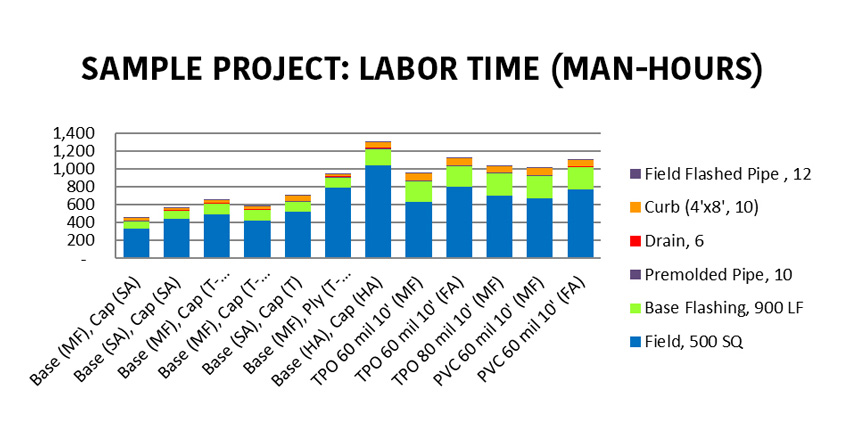Low-Slope Roofing: Specifying a Quality, Cost-Effective Roof System While Considering the Skilled Labor Shortage
Tool Management
Beyond the efficient staging of tools for crew use, the type and condition of tools is a contributing factor to crew efficiency. Using the effective and well-kept tools, such as automated screw and plate installers, rooftop generators for consistent power, and power tools, all contribute to increased performance. For example, under the right conditions, significant time savings can be realized by using a multi-torch cart, or “dragon wagon,” on the field application of a torch-applied project.
Even if a contractor is using the best tools, proper maintenance and availability of the replacement parts are needed for effective and efficient installation projects. Using the “dragon wagon” example, the time savings observed during the study could easily be reversed into lost time had a crew relied on such a tool and experienced a tool malfunction with no crew member or parts on-site to remedy the issue.
Before settling on a roofing system and contractor, specifiers may want to talk to references and visit job sites to better understand a contractor’s process. A roofing contractor with a reputation for quality and on-time work likely will be eager to share its efficient processes.
Understand How Product Selection Will Impact and Be Impacted by Labor Costs
According to the study, when roof coverings are installed in accordance with manufacturer’s published installation recommendations, by trained crews, with proper tools and management, in relatively temperate climates, there are clear differences in labor needs across roof covering types, as shown in Figure 2.

Source: Factors Impacting Low-Slope Roofing Costs – A National Labor Study, June 2018
Figure 2: Man-hour comparison for sample project
When the study data is applied to a sample project, the fastest installed roof covering was a two-ply bituminous system with a mechanically attached base sheet and a self-adhered cap sheet, demonstrating the benefits of new technologies in asphalt roofing. In contrast, the slowest installed system was a bituminous system with both the base sheet and cap sheet installed with hot asphalt, requiring almost three times the labor effort over the self-adhered system. Further, a 60-mil mechanically attached TPO covering required more than twice the labor of the self-adhered two-ply bituminous system. The data verifies that newer, high-performance modified bitumen roofing systems are quickly installed and debunks the myth that a multilayer system cannot be installed competitively with a single-ply system.
As mentioned earlier, Figure 2 also illustrates the impact of roofing detail elements on the overall labor needs of a project. The type of flashing detail was observed to have significant bearing on the labor required and the difference in labor across roof coverings. Base flashing and equipment curbs require more labor and have a wider delta for observed time to complete across roof coverings.
Referencing the sample project, the total man-hours required for 900 lf of base flashing are:
- mechanically attached bituminous base and self-adhered cap: 82.5 man-hours.
- mechanically attached bituminous base and hot-applied cap: 116.25 man-hours.
- mechanically attached 10-foot, 60-mil TPO: 228.75 man-hours.
The difference between the fastest observed installed base flashing, mechanically attached bituminous base sheet and self-adhered cap, and the 10-foot, 60-mil, TPO-installed base flashing is equal to $6,581 in sample project labor costs.
Flashing details such as pipes and drains, however, require relatively little time to install regardless of product selection. The average time to complete a drain detail across all observed roof coverings was 64 man-minutes. When the task data is applied to the sample project, the difference in drain detail labor needs between the slowest roof covering and the fastest roof covering was a total of 97.5 man-minutes, less than $100 difference in labor cost at a burdened labor rate of $45/hour.
While other factors must be considered, it can be concluded that product selection is a way to offer labor savings to your clients. The study demonstrated that self-adhered bitumen roof systems can offer labor cost savings while providing a historically proven level of safety and durability that multilayer modified asphalt roof systems are known for.
Conclusion
Design professionals must always find the balance between quality and cost when specifying roofing systems for their clients, who ultimately make purchasing decisions by weighing installed cost against value; in this case, how likely the roof is to protect the building and its occupants/assets. To meet this challenge, when comparing roofing systems, it is important to understand the roofing contractor labor market and how the current construction labor shortage can affect the proper and cost-effective application of the specified roof covering. The installed costs of any roofing system can skyrocket due to unskilled applicators, poorly managed crews, malfunctioning tools, and extreme climate conditions.
This national labor study concluded that modified bitumen, multilayer roofing systems can be installed cost-competitive with single-ply coverings. Given the current skilled labor shortage and bitumen roofing’s more than 100-year track record of successful performance, self-adhered modified bitumen was shown to be a quality and cost-effective specification choice that can meet the challenge of providing clients with cost-saving opportunities while supporting the durability of a roofing specification.
However, there is no one solution in the roofing market. Project-specific considerations, such as building type, roof design, roofing contractor, local climate, and budget, may affect the value of one system over another. To help ensure success and meet client and project goals, all aspects of the project goals and parameters need to be considered when selecting products and roof assemblies. In addition, the study results clearly indicate that for any product a certain level of expertise and proper crew and tool management (including quality control) are key factors to ensuring long-term performance of a selected system, while a lack of these can significantly affect the final product.
End Notes
1Databases, Tables & Calculators by Subject. Bureau of Labor Statistics. United States Department of Labor. Web. 8 Oct. 2018.
2Distribution outlets were a combination of national and regional roofing wholesalers responding to an RFP for 500 squares of products.










